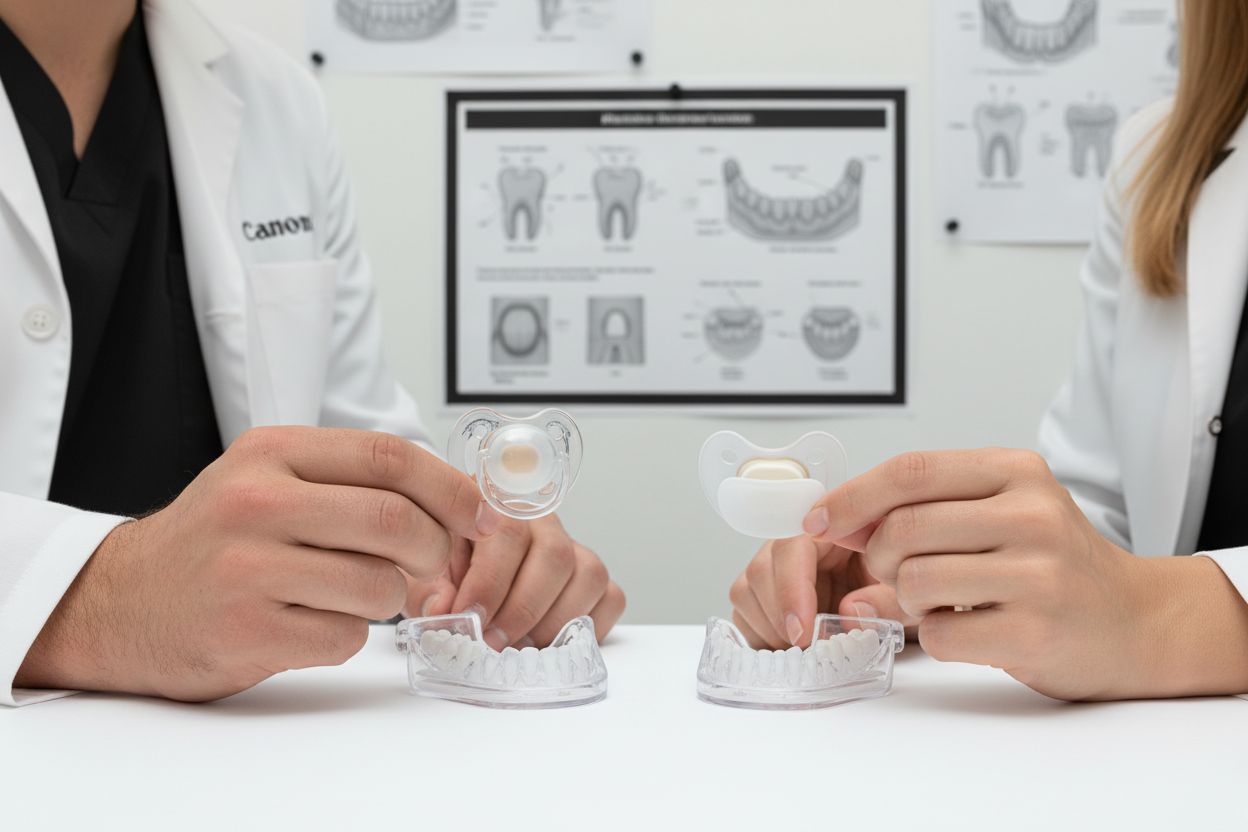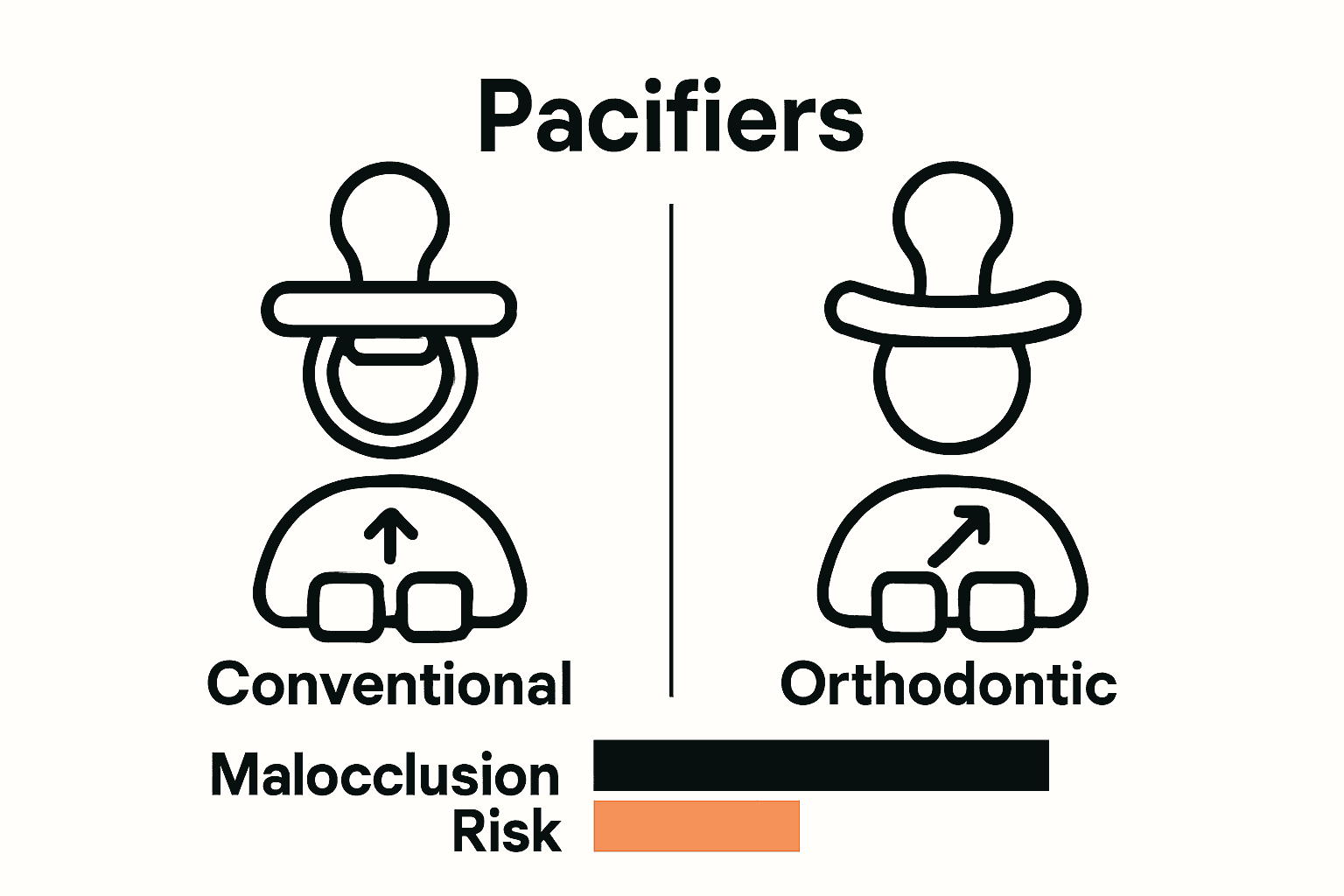Effects of Pacifiers on Teeth: Complete Guide
October 18, 2025
Effects of Pacifiers on Teeth: Complete Guide
Did you know that nearly 75 percent of infants use pacifiers within their first year? Parents worldwide rely on these soothing tools, yet the impact of pacifiers goes far beyond calming a fussy baby. Between supporting sleep, easing discomfort, and even lowering the risk of sudden infant death syndrome, pacifiers play a complex role in early childhood. Understanding their benefits and potential dental effects can help families make informed decisions about their child’s health and comfort.
Key Takeaways
| Point | Details |
|---|---|
| Pacifier Functions | Pacifiers soothe infants, engage the sucking reflex, and may reduce SIDS risk, but prolonged use can impact oral development. |
| Design Differences | Orthodontic pacifiers minimize dental misalignments better than conventional designs, promoting proper tongue posture. |
| Dental Risks | Extended pacifier use beyond three years can lead to significant dental complications, including malocclusions and potential speech issues. |
| Management Strategies | Parents should limit pacifier usage, choose orthodontic designs, and consult pediatric dentists to mitigate dental risks. |
Table of Contents
- What Are Pacifiers And How Are They Used
- Types Of Pacifiers And Dental Designs
- How Pacifiers Affect Teeth Development
- Potential Dental Risks And Long-Term Effects
- Tips For Minimizing Dental Issues
What Are Pacifiers And How Are They Used
Pacifiers are small, nipple-shaped devices designed to help soothe and comfort infants by mimicking the natural sucking motion babies experience during breastfeeding. Pacifiers are typically made from soft silicone or rubber materials and come in various shapes and sizes to accommodate different infant age groups and preferences.
According to a 2025 scoping review, pacifiers serve multiple important functions beyond simple comfort. They help engage an infant’s natural sucking reflex between feedings and potentially reduce the risk of sudden infant death syndrome (SIDS). The review highlights that while pacifiers offer significant short-term benefits, parents should be mindful of prolonged use, which can potentially impact oral development and tooth alignment.
The use of pacifiers varies across different cultures and socioeconomic backgrounds. A 2025 cross-sectional study in Saudi Arabia found pacifier usage was particularly common among:
- First-born children
- Infants who are both bottle and breastfed
- Children aged 2 to 4 years
While pacifiers can be an excellent tool for soothing babies, pediatric experts recommend monitoring usage and gradually reducing dependency as children grow older to minimize potential long-term dental and oral development concerns.
Types Of Pacifiers And Dental Designs
Pacifiers are not a one-size-fits-all solution, and their design can significantly impact a child’s oral development. Pacifier types range from traditional round nipples to more specialized orthodontic designs, each with unique characteristics that affect dental health and comfort.
According to a biomechanical analysis, there are critical differences between conventional and orthodontic pacifier designs. Conventional pacifiers typically feature a round or symmetrical nipple that can potentially exert uneven pressure on an infant’s palate. In contrast, orthodontic pacifiers are engineered with flattened or angled nipples specifically designed to support proper tongue posture and minimize the risk of dental misalignments like open bite or crossbite.
A computational simulation study comparing pacifier designs revealed remarkable insights into their impact on dental structures:
- Orthodontic pacifiers reduced palatal stress regions by over 90%
- Standard pacifiers also demonstrated significant tooth displacement reduction (up to 79%)
- Conventional designs showed the highest potential for dental misalignment
Parents should consider consulting with pediatric dentists to select a pacifier design that best supports their child’s oral development. While orthodontic pacifiers show promising results in minimizing potential dental issues, individual factors like age, sucking habits, and specific oral anatomy should guide the selection process.

Here’s a comparison of conventional vs. orthodontic pacifier designs:

| Feature | Conventional Pacifiers | Orthodontic Pacifiers |
|---|---|---|
| Nipple Shape | Round Symmetrical |
Flattened Angled |
| Pressure on Palate | May be uneven | Evenly distributed |
| Dental Alignment Impact | Higher misalignment risk | Lower misalignment risk |
| Support for Tongue Posture | Limited | Improved |
| Reduction in Palatal Stress | Lowest | Over 90% reduction |
How Pacifiers Affect Teeth Development
Pacifier use can have profound implications for a child’s dental development, with long-term consequences that extend beyond simple comfort. Dental impacts of pacifier use are nuanced, influenced by factors like duration, frequency, and design of the pacifier itself.
According to a 2025 scoping review, prolonged pacifier use is directly linked to several types of malocclusions. Specifically, children who use pacifiers extensively may develop:
- Anterior open bite: A gap between upper and lower front teeth when the mouth is closed
- Posterior cross-bite: Misalignment of back teeth when the jaw is closed
- Increased overjet: Horizontal distance between upper and lower front teeth
A randomized controlled trial in Finland provided critical insights into long-term dental risks. The study found that children using pacifiers for 12 months or more were more likely to develop posterior cross-bite by age 7. Interestingly, while orthodontic pacifiers showed some potential for reducing these risks, the difference was not statistically significant.
Parents should be strategic about pacifier use, considering both immediate soothing benefits and potential long-term dental consequences. Recommendations include limiting pacifier use as children grow, gradually reducing dependency, and choosing orthodontically designed pacifiers when possible.
Regular dental check-ups can help monitor and address any emerging alignment issues early in a child’s development.
Potential Dental Risks And Long-Term Effects
Pacifier use, while comforting for infants, can lead to significant dental complications if not managed carefully. The potential risks extend far beyond simple tooth alignment, impacting overall oral development and functional capabilities.
According to a comprehensive scoping review, prolonged pacifier use beyond three years substantially increases the likelihood of structural dental changes requiring orthodontic intervention. Long-term pacifier dependency can trigger multiple dental and functional challenges, including:
- Increased risk of malocclusions
- Potential speech development interruptions
- Swallowing mechanism complications
- Higher probability of dental trauma
A randomized controlled trial provided additional insights into the long-term consequences of persistent non-nutritive sucking habits. The research revealed that consistent pacifier use beyond one year is strongly associated with posterior cross-bite development. Similarly, digit sucking habits contribute to tooth crowding, further emphasizing the orthodontic risks associated with prolonged oral fixation behaviors.
Parents and caregivers should adopt a proactive approach to pacifier management. This includes monitoring usage duration, gradually reducing dependency, and consulting pediatric dental professionals for personalized guidance. Early intervention and strategic pacifier use can minimize potential dental risks while still providing the comfort and developmental benefits these tools offer to infants and young children.
Tips For Minimizing Dental Issues
Navigating pacifier use requires a strategic approach that balances infant comfort with long-term dental health. Dental prevention starts with understanding how to manage pacifier habits effectively and proactively.
According to a comprehensive review, early intervention and caregiver education are crucial in minimizing oral health risks. Parents can implement several key strategies to reduce potential dental complications:
- Choose orthodontic pacifiers designed to support proper oral development
- Limit pacifier use to specific times, such as sleeping or moments of significant distress
- Begin gradual weaning process around 12-18 months
- Avoid using pacifiers as a constant soothing mechanism
A study on parental awareness in Saudi Arabia highlighted the importance of understanding potential risks. Parental education plays a critical role in promoting healthier oral habits, including avoiding practices like dipping pacifiers in sweeteners, which can lead to additional dental problems. Practical tips for minimizing dental issues include:
- Consult pediatric dentists regularly
- Monitor pacifier condition and replace when worn
- Gradually reduce pacifier dependency
- Encourage alternative soothing techniques as children grow
Ultimately, the goal is to balance the immediate comfort pacifiers provide with long-term oral health considerations. Thoughtful, informed approach to pacifier use can help prevent potential dental misalignments and support healthy oral development in young children.
Give Your Child the Best Start to Lifelong Oral Health
Worried about how pacifier habits might affect your child’s teeth? The article you just read highlights real concerns like dental misalignment, open bite, and long-term risks from prolonged pacifier use. Many parents feel anxious about making the right choices for their child’s oral development and want clear guidance backed by expertise. At Glow Orthodontics, we understand the importance of early prevention and the unique needs every child has when it comes to their smile.

Let our experienced orthodontic team give you peace of mind. We offer personalized consultations to assess your child’s dental development and provide recommendations that fit your family, whether you are interested in early evaluations or orthodontic solutions like Invisalign. Experience our warm and welcoming approach by visiting our official site Glow Orthodontics for more details or to book your first appointment online. Protect your child’s smile today and set the foundation for a lifetime of confidence and health.
Frequently Asked Questions
What are the effects of pacifier use on dental development?
Prolonged pacifier use can lead to various dental issues such as anterior open bite, posterior cross-bite, and increased overjet. These conditions can affect the alignment of teeth and require orthodontic intervention in some cases.
How can I choose the right type of pacifier for my child?
It’s recommended to opt for orthodontic pacifiers as they are designed to support proper tongue posture and minimize the risk of dental misalignments. Consult with a pediatric dentist to determine the best design for your child’s specific needs.
When should I start weaning my child off the pacifier?
Experts suggest beginning the weaning process around 12-18 months to reduce dependency on pacifiers. Gradual weaning can help minimize potential dental issues as your child grows.
What strategies can help minimize dental issues from pacifier use?
To reduce dental complications, choose orthodontic pacifiers, limit usage to specific times, monitor the condition of the pacifier, and encourage alternative soothing methods as children get older.